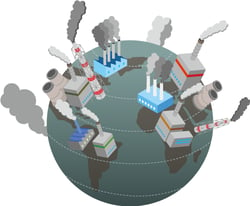 In recent years, the global conversation surrounding environmental, social, and governance (ESG) goals has gained significant traction. From corporate boardrooms to legislation to consumer demand, there is a growing interest in issues such as climate change, social inequality, and ethical business practices. But what exactly are ESG goals, why are they important, and how can we effectively track and manage them? In this article, we share some of the best practices for tracking these goals with exciting new features that allow you to monitor and measure your progress directly on your product roadmaps.
In recent years, the global conversation surrounding environmental, social, and governance (ESG) goals has gained significant traction. From corporate boardrooms to legislation to consumer demand, there is a growing interest in issues such as climate change, social inequality, and ethical business practices. But what exactly are ESG goals, why are they important, and how can we effectively track and manage them? In this article, we share some of the best practices for tracking these goals with exciting new features that allow you to monitor and measure your progress directly on your product roadmaps.
What Are ESG Goals?
ESG goals represent a set of criteria by which investors, consumers, and stakeholders evaluate a company's impact on the world beyond financial performance. Companies that declare ESG goals can set themselves apart from their competition by aligning with the issues that matter most to their consumer base. Here are some examples of goals for each section.
Environmental factors may encompass a company's carbon footprint, energy efficiency, and resource management.
Social considerations can include labor practices, diversity and inclusion, and community engagement.
Governance criteria focus on corporate governance structures, executive compensation, and business transparency.
The Importance of Setting ESG Goals
It’s not enough to publicly declare your company upholds certain values. Consumers care more than ever about the actions of the companies they support, and they want tangible results and proven commitments. This is why it is essential to publicly state and fulfill ESG goals.
Beyond fostering a more sustainable planet, companies that prioritize ESG goals alongside growth and profits outperform their peers in the long run due to their increased reputations and competitive edge. Research consistently shows that companies with strong ESG practices tend to exhibit lower volatility, attract top talent, and enjoy greater investor confidence. Moreover, consumers are increasingly aligning their purchasing decisions with ethical and sustainable values, making ESG commitments vital to doing business.
How to Set, Monitor, and Manage ESG Goals
 Setting lofty ESG goals is only the first step. To truly make an impact, companies must establish robust mechanisms to track and manage their progress towards these objectives, just as you would with any other objective and key results. Here are some steps to ensure that tracking and measuring of company goals actually happens.
Setting lofty ESG goals is only the first step. To truly make an impact, companies must establish robust mechanisms to track and manage their progress towards these objectives, just as you would with any other objective and key results. Here are some steps to ensure that tracking and measuring of company goals actually happens.
Establish Clear Metrics
When it comes to ESG goals, it’s not enough to make a public statement. A target measurement also needs to be made. Goals are always more achievable when they are specific. Companies can define measurable, time-bound targets for each ESG pillar. Whether it's reducing greenhouse gas emissions by a certain percentage in five years or increasing gender diversity on the board by a certain year, clarity in metrics is essential for accountability.
Communicate the Goals
Once ESG goals have been established, they need to be shared publicly and internally. Not only do the product management teams need to know the company priorities, but all stakeholders should be informed to ensure transparency and alignment in product decision-making.
Embedding ESG considerations into core business strategies ensures that these goals become a fundamental aspect of decision-making processes across all levels of the organization. This could involve integrating ESG metrics into idea sessions, product reviews, and performance evaluations.
Set Product Goals
 When everyone on the product team knows the company’s long-term vision, more accurate decisions can be made at the product level to support those goals. One way to ensure that everyone on the team understands the priorities is to use the product roadmap. Incorporating ESG targets into the product vision on the roadmap will ensure that product teams consider the timeframes of the goals, prioritize specific features, and track their progress.
When everyone on the product team knows the company’s long-term vision, more accurate decisions can be made at the product level to support those goals. One way to ensure that everyone on the team understands the priorities is to use the product roadmap. Incorporating ESG targets into the product vision on the roadmap will ensure that product teams consider the timeframes of the goals, prioritize specific features, and track their progress.
For instance, if the company's goal is to launch a line of carbon-neutral products by a certain year, the release dates for those product plans need to be scheduled before that deadline. If the goal is to remove environmentally harmful materials and replace them with eco-friendly ones, then product teams need to prioritize sourcing new materials or innovating new solutions before phasing out the current solution.
Continuous Monitoring and Reporting
Continuous measuring, monitoring, and reporting are useful for any product goal. The same goes for ESG goals. That’s why in our product roadmap management software, we’ve added features to track product line contributions to the ESG goals. Does your company want to reduce carbon emissions across the product portfolio or a specific market? Your teams can track which products are contributing to that goal in each product line or segment, providing a quick high-level overview of where you’re making strides and where there are opportunities for improvement.
With convenient filtering options, Gocious allows executives and management leaders to quickly highlight the products that are leading the way in ESG initiatives while providing insights into where the next phase of change needs to happen. Now your product roadmaps can drive your product strategy and enable your teams to combine business goals and ESG goals into one streamlined product strategy.
Using the product roadmap helps support the implementation of robust monitoring and reporting frameworks to track progress towards ESG targets. This can include periodic assessments, audits, and publications to ensure accountability and transparency.
Engage Stakeholders
 Collaboration with stakeholders, including investors, employees, customer user base, and communities, is crucial for garnering support and feedback on ESG initiatives. Regular communication and transparency foster trust and demonstrate a genuine commitment to responsible business practices. These engagement tactics can include regular publications, company announcements and press releases, webinars, and more. Using the product roadmap to update your progress makes it easier to provide regular updates on achievements. These consistent communication touchpoints will also increase the credibility of your brand.
Collaboration with stakeholders, including investors, employees, customer user base, and communities, is crucial for garnering support and feedback on ESG initiatives. Regular communication and transparency foster trust and demonstrate a genuine commitment to responsible business practices. These engagement tactics can include regular publications, company announcements and press releases, webinars, and more. Using the product roadmap to update your progress makes it easier to provide regular updates on achievements. These consistent communication touchpoints will also increase the credibility of your brand.
Utilize Technology
Your product teams may also want to leverage technological solutions such as data analytics and artificial intelligence to gather, analyze, and report ESG-related information more efficiently and accurately. These tools can provide insights into areas for improvement and help identify emerging risks and opportunities.
With realistic targets in mind, these goals can be measured and tracked on the product portfolio. Want to see how many laptop models are incorporating the new recycled battery components? Simply filter to view the portfolio by component or ESG Goal. Tracking data is one part of the equation. Easily accessing the data you need is the key to creating transparency with product goals.
Adapt and Evolve
ESG goals should not be static; they must evolve in response to changing societal expectations, regulatory requirements, and emerging sustainability trends. Agility in product development works best when constant evaluations and assessments are made. Companies should regularly review and recalibrate their strategies to stay ahead of the competitive curve.
Measuring ESG Goals in Product Roadmaps
By prioritizing environmental stewardship, social responsibility, and sound governance practices, companies can mitigate risks and unlock new opportunities for growth and innovation. By diligently tracking and managing ESG goals, businesses can fulfill their commitment and create long-term value for all stakeholders, and effective product roadmaps can help monitor ESG performance throughout product development.
Gocious product roadmap management Software makes it easier to monitor ESG performance across multiple product lines and keep internal teams aligned with the goals. Schedule your demo of Gocious software to see ESG goal tracking in action.


